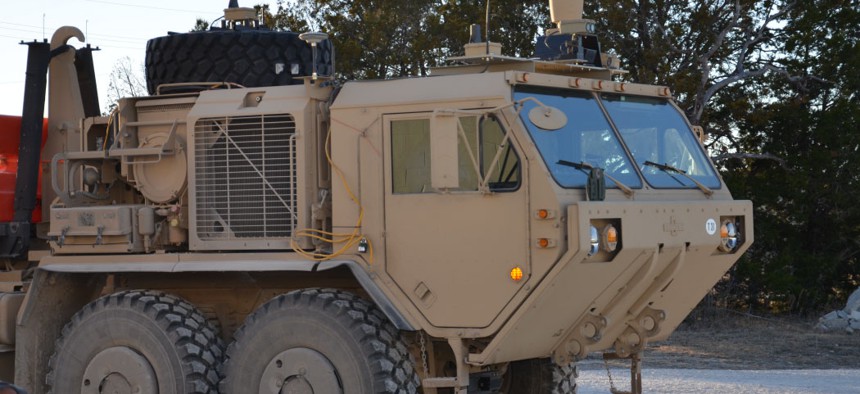Work shifts down on driverless military convoys
The deputy defense secretary expressed skepticism about autonomous vehicles in the near term, noting that unmanned wingmen in the air will occur first.
The prospect of driverless cars on the nation’s roadways may be creating a lot of excitement—and fear—but this technology that could revolutionize the way passengers travel might have to wait some time before it sees the battlefield.
Deputy Defense Secretary Bob Work expressed skepticism regarding the integration of driverless cars into the military. Driverless cars, he said in a March 30 appearance at the Washington Post, drive repeatedly on paved roads while the battlefield is much more unpredictable. “In military…not only will we stay on roads, but when the roads become more dangerous we’ll go off road. That type of navigation is extremely difficult,” Work said.
As a result he said he’d expect to see unmanned wingmen in the air before unmanned convoys, something that has been tested and discussed for some time. The concept of unmanned “wingmen,” is described by a 2010 Army Research Lab paper as an effort to “incubate the technology necessary to safely and effectively coordinate manned and unmanned aircraft systems into an efficient team.”
“In fact, the Air Force has a concept called ‘loyal wingmen’ where you take an F-16, make it totally unmanned – F-16 is a fourth generation fighter – and pair it with an F-35 – a fifth generation, what I would call battle network node – and those two operating together,” he said. The military first tested these unmanned fighter aircraft – dubbed “QF” in 2013.
Boeing’s QF-16, or any QF for that matter, could serve as a “missile truck” for the fifth-generation fighters Work referred to, according to Paul Scharre, senior fellow at the Center for a New American Security. The weapons payload capacity of fifth-generation fighters such as the F-35 and F-22 Raptor are limited. In a scenario in which operating bases will be far away because of adversaries’ anti-access area denial capabilities – something Work’s brainchild, the Third Offset Strategy is seeking to address through this manned-unmanned teaming concept – QF aircraft could help carry and deliver these payloads, Scharre told Defense Systems in an email. While this concept is nearly available today there’s still more work and investment to be done in the stealth arena to increase A2/AD capability, Scharre added.
Work’s skepticism about near-term driverless ground vehicles has been shared by others as well. Jonathan Bornstein, chief of the Autonomous System Division in the Army Research Laboratory’s Vehicle Technology Directorate, told members of Congress in November that Google’s driverless cars operate on the structured highway systems, while the military deals with dynamic environments, “where we don’t know things in advance. We have to have organic sensing and reasoning powers on board the vehicle…there’s a distinct difference there.”
Army researchers had said much the same thing during a panel discussion in April, describing the move to full autonomy as a three-phase process that would require five to 10 years to get to what they called the mid-term.
Work also expounded on the oft-feared term “autonomy,” with regard to what some people envision as the killer robots of the future. “The word autonomy to us is very simple; it is nothing more than delegating decision authority to an entity in your, what I’ll call a battle network,” he said. “And a battle network is nothing more than a sensor grid and a command and control and communications and information grid, and an effects grid and they’re all kind of stacked together.”
“Over the next five to 10 years, I would guess would be more narrow [artificial intelligence] – things like pushing a button and doing a parallel park with your car. You push the ‘I believe’ button and you believe the car is going to autonomously do that for you.” Work added that while DOD will integrate basic autonomous capabilities that respond to commands—such as pushing a button to get a car to parallel park for you—“we will not delegate lethal authority for a machine to make a decision. The only time we’ll do something [such as] give a machine delegate authority, is in things that go faster than human reaction time, like cyber or electronic warfare.”
The concept of machines making decisions has been described by some, such as Vice Chairman of the Joint Chiefs of Staff Gen Paul Selva, as the “terminator conundrum.”
As for the foreseeable future, Work said, “I would expect to see unmanned wingmen in the air first. I would expect to see unmanned systems undersea all over the place. I would expect to see unmanned systems on the surface of the sea. I’d expect to see unmanned systems delivering things to soldiers around the battlefield from the air—we’ve already demonstrated that in Afghanistan—and this is something that is inexorable, it is going to happen.”





